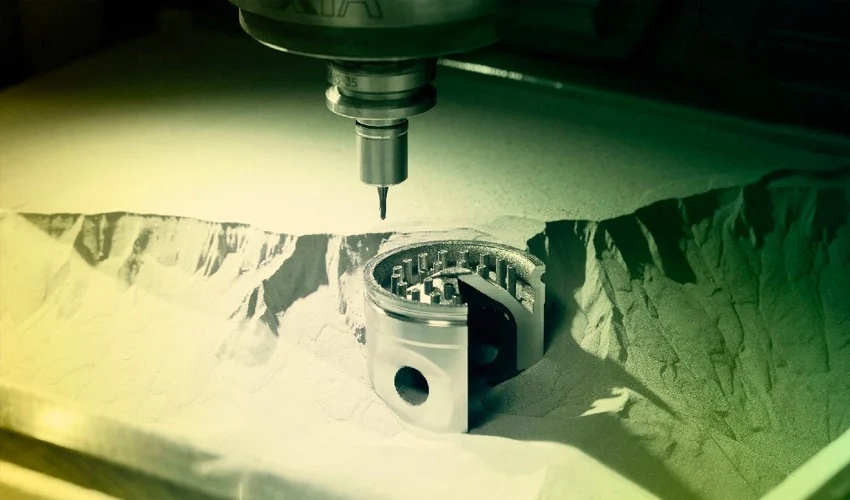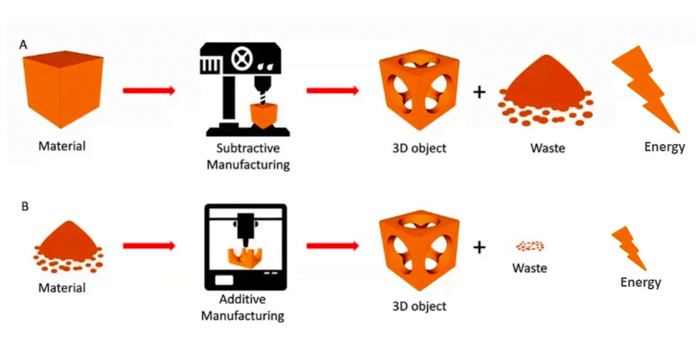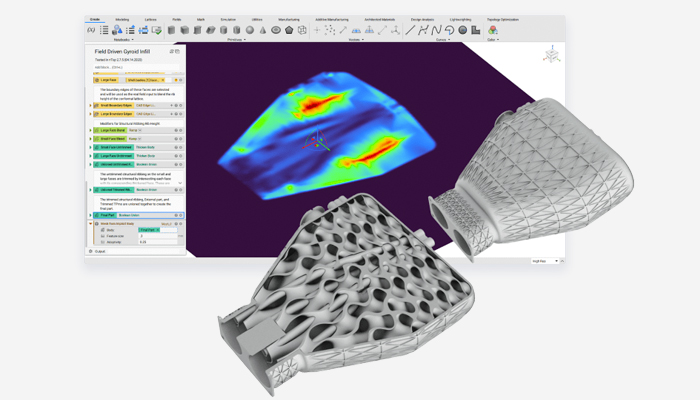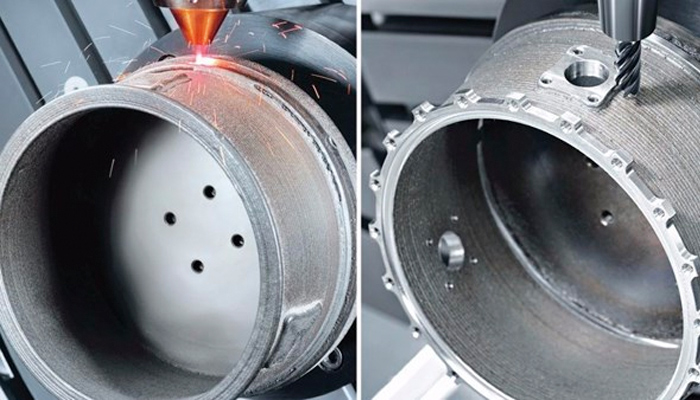How to Combine Additive and Subtractive Manufacturing in Production? Experts Give Their Advice!

In recent years, the combination of additive and subtractive manufacturing has gained in popularity, making a significant impact worldwide. Thanks to a number of technological advances, there are a wide variety of industries already benefiting from so-called “hybrid manufacturing” for the creation of final parts. Indeed, although there are differences between the two production methods, they can be used in a complementary way to get the most out of them. However, it is important to know exactly what these technologies consist of in order to be able to implement them in a company. To address this, we spoke to three experts from the manufacturing industry. They gave us their opinion and advice on how to implement additive and subtractive manufacturing optimally in the production chain.
First up is Peter Genovese, 3D printing applications engineer for SolidCAM Additive. He has been working with additive technologies for nearly a decade and draws on his professional experience to determine how additive technologies best fit into various manufacturing environments. Next, Elena Lopez works as head of the additive manufacturing department at Fraunhofer IWS. She is also an adjunct professor of additive manufacturing and is part of Women in 3D Printing as the Regional Director for Europe. Finally, Brian Kristaponis, is the General Manager of the Hybrid Division within Phillips, a leading provider of manufacturing solutions and new technologies for a wide variety of markets.
- Peter Genovese
- Elena López
- Brian Kristaponis
Characteristics of Additive and Subtractive Manufacturing
Before discussing how to implement hybrid production, it is important to understand the significant differences between the two methods. Additive manufacturing consists of layering material, layer by layer, until the desired part is created. Within the family of 3D printing technologies we can find: material extrusion, material jetting, binder jetting, vat photopolymerization, powder bed fusion, Directed Energy Deposition (DED) and sheet lamination. Meanwhile, subtractive manufacturing consists of the manufacturing of parts by extracting material from a block or larger part. These subtractive processes include CNC machining (milling, turning, drilling, boring, boring, grinding), laser cutting, electrical discharge machining and water jet cutting.
Both manufacturing processes have their strengths and their own limitations, so it is necessary to know them in order to understand what to use in each case. Let’s now look at the benefits a company can gain by combining these two technologies. SolidCAM expert Peter Genovese explains, “One of the main advantages of this kind of hybrid manufacturing is the ability to use 3D printing to first print a very complex, organic geometry that would otherwise be impossible or cost-prohibitive to produce solely with subtractive machining. Then, subtractive machining is used to attain the high levels of dimensional accuracy and tight tolerance required on critical features of the part.” Or in other words, hybrid manufacturing combines additive and subtractive, taking the best of both processes and incorporating them into a single machine, making hybrid production faster and easier to create final parts for the most demanding industries.
In terms of the process as a whole, Brian Kristaponis, adds, “A hybrid process can reduce the amount of starting material needed, which in turn can reduce the cycle time to create a near net shape. It can enable internal geometries, reduce the need for specific sizes of starting material, and lower overall tooling costs by eliminating rough machining processes.” Moreover, it is worth noting the importance of choosing the right process, both additive and subtractive, to get the most out of each specific application.

A. Subtractive manufacturing process / B. Additive manufacturing process.
If we focus specifically on 3D printing, we see that each technology has key characteristics that will affect its use as a complement to subtractive manufacturing. This is also pointed out by Elena Lopez, who explains, “Not all additive manufacturing technologies are suitable for improving the scalability of parts or making repairs in a convenient way.” Considerations to take into account in this choice include: the resolution or tolerance of the additive process, the materials compatible with the technology and the need for specific post-processing of the parts. Post-processing in particular will be discussed in more detail below.
Hybrid Manufacturing: Other Aspects to Take Into Account
Beyond the manufacturing process per se, the importance of other aspects in the production chain must also be understood. When talking about hybrid manufacturing, the first step, design, and the last, post-processing, play a key role. Knowing in detail the functions of both processes will enable companies to take full advantage of additive and subtractive production for the creation of optimal final parts.
The design phase is usually directly dependent on the manufacturing process that will be used to create the part. Both Elena and Peter agree that additive and subtractive manufacturing separately encounter more limitations in terms of design. “Not all designs can be processed on a CNC machine. Especially complex internal structures may not be the most reasonable approach,” begins Lopez. To this, Genovese continues, “Generally, with CNC machining, as design complexity increases, the difficulty of machining that part also increases. With additive on the other hand, there are many cases where an increase in part complexity doesn’t result in more complex fabrication.”
Kristaponis concludes by mentioning the design process in hybrid manufacturing: “The complexity of the internal features lends itself very well to a hybrid process. With a hybrid, you can repeat deposition and machining throughout the process. This allows us to produce parts with high-quality machined internal features that would not be possible with a strictly additive manufacturing or CNC process.” Thus, by combining the two technologies, designers have greater freedom to devise parts based on part performance, rather than being constrained by a single manufacturing method.

Design is an important phase in hybrid manufacturing (photo credits: nTopology)
On the other hand, there is post-processing. This step is fundamental in most manufacturing processes, as it enables a better surface finish of the parts or, in some cases, reinforcing their mechanical properties for more demanding applications. In this sense, the three experts agree that it is a crucial consideration, not only once the part is obtained, but even before. The type of post-processing to be implemented must be taken into account when designing the model, since the morphology of the part could vary. In fact, Lopez explains, “The expected surface roughness, depending on the hybrid processes used, may differ from that of a simple 3D printing process. If subtractive technologies are used, the amount of material to be removed must be taken into account in the design and processing routes.”
Genovese agrees on this point, but also mentions part tolerances, “One thing to remember is that you can often print shapes that you can’t machine. If you need to post-machine the part to achieve critical tolerances, make sure you can access those locations after the part is printed with those more traditional subtractive techniques.” Finally, Brian addresses the issue of post-processing by concluding, “Ideally, you want to produce a near net shape with uniform amounts of material in all directions. This makes the machining process more predictable and allows machining time to be reduced, as semi-finishing machining operations can be reduced or omitted.” This last point is interesting because otherwise we would run into certain problems. If the part is underbuilt, it is not always possible to re-deposit it, which would cause the part not meet tolerances.

In hybrid manufacturing, post-processing is used to obtain the desired surface finish. With metal technologies, it is done by techniques such as CNC machining
A Few Last Words of Advice
“Reach out to someone who has already been down this road and help guide you on your own journey. The world of additive manufacturing and CNC machining is incredibly broad. Just knowing what options are out there, let alone how to leverage those options together, is a very difficult task. Finding consultants or companies in industries similar to yours that have had success with hybrid manufacturing are excellent resources to help you sift through all the options.” – Peter Genovese
“You have to carefully analyze the intended use case and evaluate what is most important to them. Adding CNC machining technologies requires hiring or training an expert in these other technologies. The hybrid manufacturing solution may not be the most cost-effective, but it can add flexibility for future applications.” – Elena Lopez
“With hybrid machines using CNC machines as the motion control system, you need a CAM software solution that supports both technologies equally. As more machines enter the market, software companies will devote more resources to making it easier and faster to program these machines and achieve seamless integration between additive and subtractive.” – Brian Kristaponis
What do you think of the combination of additive and subtractive manufacturing in production? Let us know in a comment below or on our LinkedIn, Facebook, and Twitter pages! Don’t forget to sign up for our free weekly Newsletter here, the latest 3D printing news straight to your inbox! You can also find all our videos on our YouTube channel.
*Cover Photo Credits: Cenit










